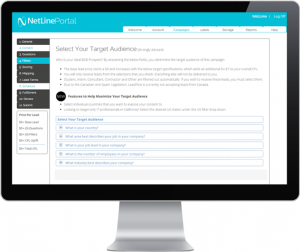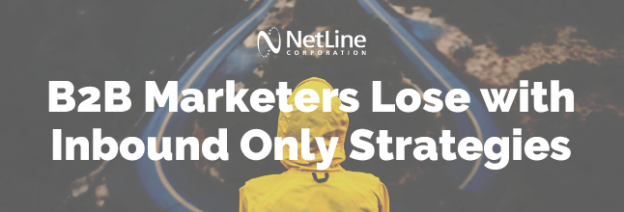B2B marketers, it’s time to wake up and smell the content marketing opportunity outside of inbound. Inbound marketing is an obvious and must have strategy for all corporate websites, no disagreement there; however, that is simply one piece of the pie.
You’ve created content, published it in the “Resources” section of your website, gated the content to capture leads, and now you’re done…wrong. While strategies outside of inbound marketing can seem highly advanced, technological, and sophisticated – they don’t actually need to be so intimidating. In some cases, strategies outside of inbound might actually be easier for online marketing newcomers to take advantage of. I encourage you to read this post to make sure you’re not losing lead generation opportunities.
WHAT’S AN INBOUND STRATEGY?
Inbound marketing runs on the assumption that marketers can continuously drive a high volume of qualified traffic to their own website which will convert prospects at a high enough rate to accelerate their sales funnel. Put in very simple terms: Attracting potential customers to your brand and/or website. For inbound marketing to be effective all of the below steps need to take place:
- 1. Create compelling content to publish on your website
- 2. Create campaigns to drive traffic to your website
- 3. Create mobile optimized landing pages to support your campaign traffic
- 4. Create lead generation forms capture the traffic
There are many steps and tools involved in making this funnel successful, plus traffic driving campaigns can be difficult and costly to achieve in large enough numbers to make an impact.
This theory is based on making your future customers come to you…while there is an entire network of customers that you can actively be reaching elsewhere.
CONTENT SYNDICATION FOR B2B MARKETERS
Whether you have built out a flashy new “Resources” section on your corporate website with a million different capture points – or not – there are other strategies that can and should be implemented to increase the impact of your content marketing efforts. Running online marketing campaigns outside of your own website significantly increases your opportunity to reach a larger volume of prospects.
Additionally, this type of strategy actually removes the burden from you (the marketer) having to implement the above 4 step flow, to be successful. By running campaigns independent of your own website, external vendors become responsible for the heavy lifting, including: reach, technology, and experience — and allows you to focus on what you do best.
WHAT IS CONTENT SYNDICATION?
Content syndication places your content in front of prospects as they actively consume content across the web with the ability to consistently find new and growing audiences.
Why it makes sense:
- Greater Content ROI: Do more with your content production investment than publishing to your own web properties. Implementing syndication campaigns will create more visibility for your content and increase the opportunity to attract and convert new customers. Why wait for your prospects to arrive?
- New Audiences: Utilizing the power of syndication networks will increase the size of the prospect pool you are able to reach. Speaking to the same audience repetitively will burn through your opportunities quickly.
- Native Experiences: Reaching prospects where they are already consuming content will create a more native experience with higher engagement potential.
What’s missing:
- B2B Level Targeting: The most popular content syndication networks available today are B2C based tools. Why does this matter? As a B2B marketer, reaching thousands of people is not effective or efficient without B2B specific controls. While many networks do have targeting capabilities, the standard targeting set typically only includes: age, gender, geography, and interests – again, not helping a B2B marketer that is more interested in professional level targeting of: job level, function, industry, and company size.
- Cost: Paying to reach audiences at a cost-per-click (clicks) or cost-per-million (impressions) where you cannot narrow in on a B2B specific audience can be extremely costly while delivering poor quality – placing you at risk for meeting B2B demand generation goals.
- Lead Generation: While the number one goal for B2B marketers is to drive qualified prospect acquisition to accelerate the sales funnel, content syndication campaigns commonly only drive traffic and brand awareness. Marketers are held responsible for capturing the prospect on their own website with their own forms outside of the syndication campaign.
Top tools for content syndication only campaigns that do not include lead generation: Outbrain, Taboola, LinkedIn.
FINDING A COMPREHENSIVE SOLUTION FOR B2B MARKETING
Taking content syndication a step further by implementing campaigns attached to lead generation immediately becomes more powerful. Next, refining campaigns to B2B specific audiences and tools is the game changer. When choosing a solution to compliment your inbound strategy, here are 5 main questions to ask:
- Content syndication networks: What types of publishers are included in the network and do the publishers align with the B2B specific nature of your content? Depth and diversity of publisher adoption is crucial.
- Scale: Relevance is an important first step to driving quality engagement; however, yielding a handful of leads per month from small audience pools is not going to be meaningful for your business. Be sure to validate that you can tap into scalable audiences that will support repeated success.
- Professional level targeting: Do the targeting options go beyond the basic age, gender, and interest options to better refine the audience pool?
- Lead generation forms: Do the lead forms include the job and company specific questions that you need answered to determine if the prospect is a qualified lead? Plus, as a best practice, confirm that the forms are optimized for mobile content consumption. According to Google, 42% of researchers use a mobile device during the B2B purchasing process.
- Performance-based cost structure: Does the campaign cost structure ensure that you will only pay for quality leads versus clicks and traffic? Why pay for a campaign that is not required to deliver leads? This can be a trap, don’t fall for it.
STOP WAITING FOR YOUR CUSTOMERS TO COME TO YOU
 Just this month NetLine Corporation released a redesigned self-service content syndication lead generation tool to enable all B2B marketers to run successful performance-based campaigns reaching new audiences. The NetLine Portal syndicates the largest collection of B2B specific content and generates quality leads with advanced targeting technologies and filtering capabilities into one smart and simple solution that all levels of marketers can easily utilize.
Just this month NetLine Corporation released a redesigned self-service content syndication lead generation tool to enable all B2B marketers to run successful performance-based campaigns reaching new audiences. The NetLine Portal syndicates the largest collection of B2B specific content and generates quality leads with advanced targeting technologies and filtering capabilities into one smart and simple solution that all levels of marketers can easily utilize.
B2B marketers, try it today by creating a free account to see how easy it is to build and launch a campaign in minutes.
Remember, outbound marketing campaigns don’t have to be complicated, stop waiting for your customers to come to you.
Post originally appeared on Marketing Insider Group.
